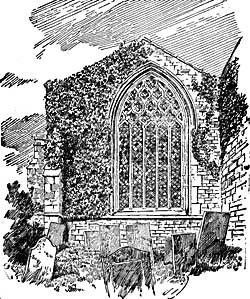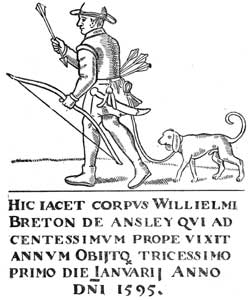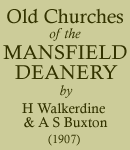< Previous | Contents | Next >
Annesley (continued)

The Felley Chapel.
Prior to Mr. Saunderson's days the living was held by Mr. Cuthbert Stoyte, for in July, 1656, it was recorded that £50 should be continued " unto such minister . . . of the church of Annesley certified not to be worth more than 20 markes since enjoyed by Mr. Cuthbert Stoyte there, who hath now left." This gentleman could not have long held the living, for at the survey held six years prior to the above mentioned date "there is noe viccar, nor curate there now." In the chancel is a recumbent effigy of a lady wearing a wimple, and in the Felley chapel at the east end is another tomb with stone effigy, but this is a gentleman, wearing a cloak. There are several incised stones, one in the chapel having had four brasses inset, but they have all beer, removed. An incised monumental tomb of the 16th century is in a very bad state of repair, but sufficient can be seen of the warrior with his sword beside him to fix the date. Close to the font is another incised slab. In the chancel a mural tablet is fixed to the "memory of John Geo. Musters late 10th Hussars, born in 1807, died in 1842, and of Emily, his wife, who died in 1845, the daughter of Philip Hamond, Esq., of Wertacre. Their children were—Mary Anne Chaworth, born 1839, married 1863, Horatio Packe, R.N.; born 1841, died 1879, and John Chaworth Musters, born 1838, by whom this tablet is erected."
Also in the chancel on a stone may be read the following:—"In memory of John Musters, Esq., of Colwick, and West Bridgford, born in 1777, died in 1849, and of Mary Ann, his wife, born in 1785, died in 1832, the only daughter of George Chaworth, Esq., and heiress of Annesley, Wiverton and Edwalton. Their children were John George, in the army, died 1842; William Musters, in holy orders, died 1870; Henry, in the army; Charles, in the navy, died 1832; Mary Ann, married Anthony Hammond, of Westacre; Sophia Caroline, married Robert Hammond, and Alicia Augusta. This tablet is erected to the memory of his grandfather and grand mother, who were buried in Colwick Church, by John Chaworth Musters their successor. It was Mrs. Mary Ann Musters who took refuge in the grounds of Colwick Hall when the rioters, after the Lords had rejected the Reform Bill, visited that residence. She had been confined to her bed, but at the time of the attack was sitting in the drawing-room with her daughter and a lady visitor. They happily escaped to an adjoining shrubbery, and notwithstanding a heavy downpour of rain lay concealed under the foliage of some thick spreading laurel tree till the rioters took their departure. Mrs. Musters died the following year. It might interest some readers to know that the beautiful and valuable furniture of the hall, some paintings, in short, whatever the mob could lay their hands on were destroyed. All food and wine were taken, and plate, jewellery, and wearing apparel carried off, many of the rioters dressing themselves in what garments they could find, and putting their own clothes over them. This lady's death has, by some writers, been attributed to the rioters' visit. At all events she lived but a short time after.

The Annesley Brass.
A mural tablet in the nave, on the north wall, is to the memory of the Rev. Rd. Howard Frazell, for 20 years the beloved and respected vicar of Annesley, who died 12th of April, 1869 aged 68 years. The parishioners defrayed the cost of this monument. There are inside the altar rails several brasses let into the floor, to members of the Chaworth family, the earliest one being; dated 1719. This was the date of the death of the husband, the wife, Elizabeth Chaworth, being interred 27th November, 1724, and their son Charles, 19th April, 1770. Patricus Chaworth was buried 5th April, 1731, Mary Ann, his wife, 16th November, 1778, William Chaworth, 8th February, 1765, William his " coz," 10th November, 1771, and outside the altar rail enclosure is a brass to George Chaworth, Esq., interred 26th, April, 1758. In the centre aisle are similar memorials to Thos. Hodgkinson, and Sarah, his wife, who died in 1803 and 1801 respectively.
Torre's list of cantarists at Annesley is appended:—
1364. Joh de Breton.
1383. Math de Upton.
392. John Manthorp.
Ric Gresley.
1435. Matthews Kilchese.
1459. Math Kilchreth.
1455. Ric Bunney.
1486. Joh Savage.
1538. Tho Matley.
To this list should be added the name Ed. Curness, who was chantry priest in 1548, vide Parliamentary Inquiry.
From the same source (Torre) we learn of the two following testamentary burials:—
16th January, 1606. Henry Chaworth, Esq., to be buried in the church near his wife s deske, where he hath fixed in the wall a white alabaster stone therein mentioning how he is descended from George Chaworth, Esq., father of Sir John Chaworth, Kt., deceased, under which he desires to be buried.
May 1st, 1626. Geo. Chaworth, of Annesley, to be buried in the chancell over againist a monument in the north part thereof in the like manner as that is.
There is no list of rectors extant, so far as we know, but from the registers and other sources we have been able to compile the subjoined:—
1599. Thomas Kirkble.
1650. "Neither vicar nor curate."
1656. Cuthbert Stoyte.
1656. Christopher Saunderson.
1689. Edw. Hawkins.
1695. Richard Kaye.
1700. An Mathews.
1764. Robert Stanley.
1795. Thomas Cursham.
1849. Rd. H. Frazell.
J. J. Trebeck.
1871. C. H. Prance.
1890. W. H. Kynaston.
There was a Kaye—John Lister—prebendary of York, and rector of Kirkby in 1765, but whether he was related to the Annesley parson we cannot say. Andrew Mathews held the living for over half a century. Thomas Cursham resided at Sutton-in-Ashfield, we learn from the following entry in the register—Abraham Ollevant, of Kirkby, and Mary Atkinson of. Annesley, were married in 1797, by Charles Sanders, and entered in the No. 1 volume with the signatures of the witnesses in the proper place with this note: " N.B.—The minister (who resides at Sutton) having forgotten to bring the Register from home, this marriage was entered in the oldest Register and properly signed and attested, and was intended to be signed here in its proper place, but the parties could never all be got together. Tho Cursham (Delivered in at Nottingham 23rd April, 1798, for one year, from January, 1797, to January 1798.")
A few particulars about the registers may be read with interest. There are altogether eleven registers of one kind or another. (1) Is a long narrow vellum bound book containing christenings, marriages, and burials commencing A.D., 1599, and ending 1682. (2) A less long, but broader book in vellum boards, outside date 1706-91 (inside is stated that it was bought in 1711) contains marriages, baptisms, and burials commencing 1700, ending 1791. (3) A much tattered book in vellum cover containing banns, and marriages registered from 1754 to 1806. (4) Vellum paper book bound in leather boards, has burials registered at one end and baptisms at the other commencing 1791, and ending 1812. This volume also contains a summary of receipts and expenditure in connection with the building of the new parish church, consecrated by the first Bishop Suffragan of Nottingham, on Easter Tuesday, 1874. (5) Is a square book in shape, and contains a few banns and marriages between the years 1806 —1813. The others are comparatively modern books, and description is therefore unnecessary. On the first and second pages of the registers marked Nos. 1 and 2 there is a list of Patricius Chaworth's children, numbering 14, and on the back cover is: "Mem. Patricius Lord Chaworth married Lady Grace Manners, daughter of the then Earl of Rutland," but no date is given. Amongst the trades, or descriptions given of persons entered in the early registers are: Labourer, servant, weaver, husbandman, pauper, baylife to Rt. Hon. the Lord Viscount Chaworth, Mary Webster, a tinker's wife, a travelling girl, a travelling woman, a poor traveller, and " a child at nurse, name not known." There are several entries which record that the consent of parents had been secured to the marriage of the parties, whose names follow. Here is one: 1754, William Hardstaff of this parish, and Elizabeth Marriott, also of this parish, were married in this church by licence with the consent of parents, this 8th day of July, 1754, by Andrew Mathews, curate.
A curious entry dated 1760 is thus: Thos. Wass of the parish of Selston, aged 28 years, married N. Duffield, aged 22.
Here is another: 1761, Benjamin Raworth, of Haynor, 22 years, and Mary Wetton, of this parish, 19 and upwards, were married with the consent of their parents.
There is recorded in 1765 a marriage conducted by George Mason, curate at Mansfield, who afterwards became Bishop of Sodor and Mann. This fact is noted in the register.
1772, February 4th, Thos. Rhodes and John Naylor, who died through ye inclemency of the weather, February 1st, 1772.
Groves, in his history of Mansfield, has a reference to the death of these men. He says so severe was the frost during the latter part of the month of January, 1772, the oil in the public cisterns was frozen. On the 11th of February the cold was more intense. Mr. Thomas Rhodes, butler to Mr. Chaworth, of Annesley, in company with a man named John Curtis (?) of the same place were proceeding on the road to Mansfield with a team of horses when they met near the "Hut" (this is near to the entrance to Newstead Abbey) a foot soldier journeying in that that direction. Fearing the man might be starved to death if left to himself, Mr. Rhodes generously took off the front horse of his team, and mounting the soldier thereon sent him to Mansfield, where after encountering difficulties almost incredible, he arrived in safety. His kindhearted preserver with his companion, through this step fell victims to the inclemency of the weather. The team, accustomed to the horse taken by the soldier, as a leader, on his departure refused to move. The consequence was that the two poor men, exhausted with fatigue and long exposure to the severity of the storm, lost all power to travel forward and were frozen to death on the ground, being found next morning a short distance from each other. One of them left a widow and eight children.
We have mentioned that a summary of accounts in regard to the building of the new church appears in the register. We notice therefrom that the receipts totalled £4,975 2s. 9d., and in addition R. H. Prance gave the pulpit at a cost of 80 guineas, the organ £800 and its case £330, three stained-glass windows £270, a bell £90, and completed the tower and spire, making a total of £3,374. In the list of donors Mr. R. H. Prance is put down as having given £1,387 4s., Mr. J. C. Musters £1,387 4s. and the site, Rev. C. H. Prance £834 13s. 31/2d.. friends of the Rev. C. H. Prance £148 13s., colliery lessees, £200 etc. Other generous contributors were Mrs. Musters, Mrs. Sherbrooke, Rev. J. J. Trebeok, Mr. H. Lewis and Mr. Thos. Huskinson.
